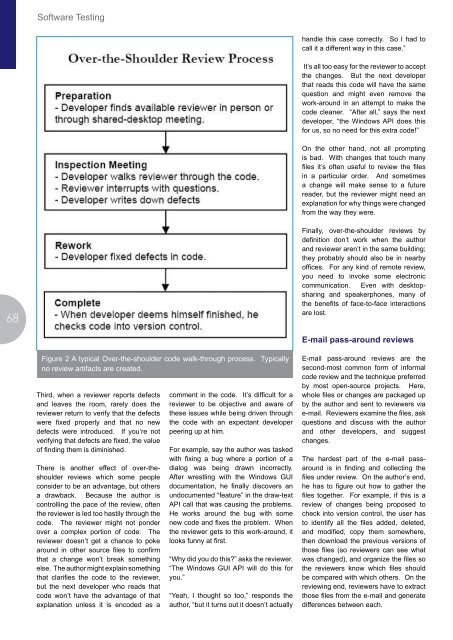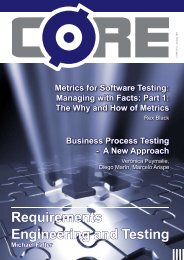Comparison of Change Management Systems
Comparison of Change Management Systems
Comparison of Change Management Systems
You also want an ePaper? Increase the reach of your titles
YUMPU automatically turns print PDFs into web optimized ePapers that Google loves.
68<br />
S<strong>of</strong>tware Testing<br />
Figure 2 A typical Over-the-shoulder code walk-through process. Typically<br />
no review artifacts are created.<br />
Third, when a reviewer reports defects<br />
and leaves the room, rarely does the<br />
reviewer return to verify that the defects<br />
were fixed properly and that no new<br />
defects were introduced. If you’re not<br />
verifying that defects are fixed, the value<br />
<strong>of</strong> finding them is diminished.<br />
There is another effect <strong>of</strong> over-theshoulder<br />
reviews which some people<br />
consider to be an advantage, but others<br />
a drawback. Because the author is<br />
controlling the pace <strong>of</strong> the review, <strong>of</strong>ten<br />
the reviewer is led too hastily through the<br />
code. The reviewer might not ponder<br />
over a complex portion <strong>of</strong> code. The<br />
reviewer doesn’t get a chance to poke<br />
around in other source files to confirm<br />
that a change won’t break something<br />
else. The author might explain something<br />
that clarifies the code to the reviewer,<br />
but the next developer who reads that<br />
code won’t have the advantage <strong>of</strong> that<br />
explanation unless it is encoded as a<br />
comment in the code. It’s difficult for a<br />
reviewer to be objective and aware <strong>of</strong><br />
these issues while being driven through<br />
the code with an expectant developer<br />
peering up at him.<br />
For example, say the author was tasked<br />
with fixing a bug where a portion <strong>of</strong> a<br />
dialog was being drawn incorrectly.<br />
After wrestling with the Windows GUI<br />
documentation, he finally discovers an<br />
undocumented “feature” in the draw-text<br />
API call that was causing the problems.<br />
He works around the bug with some<br />
new code and fixes the problem. When<br />
the reviewer gets to this work-around, it<br />
looks funny at first.<br />
“Why did you do this?” asks the reviewer.<br />
“The Windows GUI API will do this for<br />
you.”<br />
“Yeah, I thought so too,” responds the<br />
author, “but it turns out it doesn’t actually<br />
handle this case correctly. So I had to<br />
call it a different way in this case.”<br />
It’s all too easy for the reviewer to accept<br />
the changes. But the next developer<br />
that reads this code will have the same<br />
question and might even remove the<br />
work-around in an attempt to make the<br />
code cleaner. “After all,” says the next<br />
developer, “the Windows API does this<br />
for us, so no need for this extra code!”<br />
On the other hand, not all prompting<br />
is bad. With changes that touch many<br />
files it’s <strong>of</strong>ten useful to review the files<br />
in a particular order. And sometimes<br />
a change will make sense to a future<br />
reader, but the reviewer might need an<br />
explanation for why things were changed<br />
from the way they were.<br />
Finally, over-the-shoulder reviews by<br />
definition don’t work when the author<br />
and reviewer aren’t in the same building;<br />
they probably should also be in nearby<br />
<strong>of</strong>fices. For any kind <strong>of</strong> remote review,<br />
you need to invoke some electronic<br />
communication. Even with desktopsharing<br />
and speakerphones, many <strong>of</strong><br />
the benefits <strong>of</strong> face-to-face interactions<br />
are lost.<br />
E-mail pass-around reviews<br />
E-mail pass-around reviews are the<br />
second-most common form <strong>of</strong> informal<br />
code review and the technique preferred<br />
by most open-source projects. Here,<br />
whole files or changes are packaged up<br />
by the author and sent to reviewers via<br />
e-mail. Reviewers examine the files, ask<br />
questions and discuss with the author<br />
and other developers, and suggest<br />
changes.<br />
The hardest part <strong>of</strong> the e-mail passaround<br />
is in finding and collecting the<br />
files under review. On the author’s end,<br />
he has to figure out how to gather the<br />
files together. For example, if this is a<br />
review <strong>of</strong> changes being proposed to<br />
check into version control, the user has<br />
to identify all the files added, deleted,<br />
and modified, copy them somewhere,<br />
then download the previous versions <strong>of</strong><br />
those files (so reviewers can see what<br />
was changed), and organize the files so<br />
the reviewers know which files should<br />
be compared with which others. On the<br />
reviewing end, reviewers have to extract<br />
those files from the e-mail and generate<br />
differences between each.



